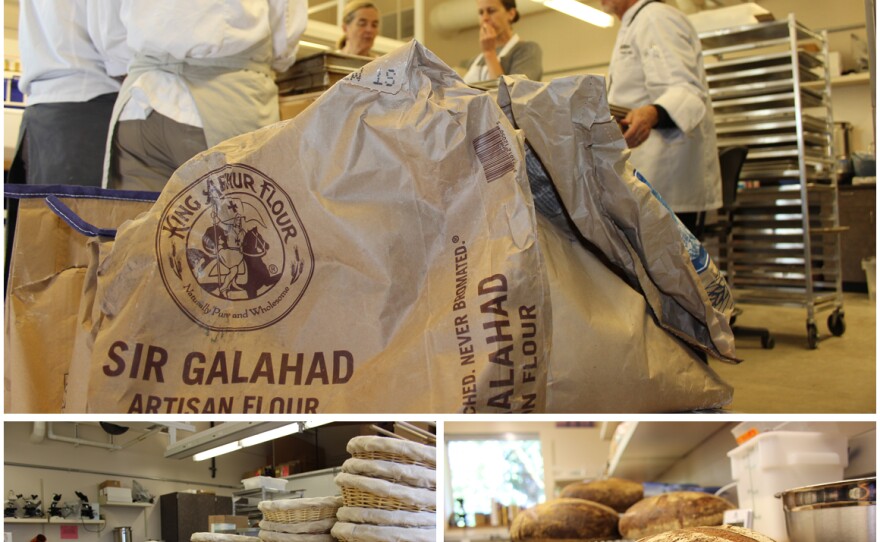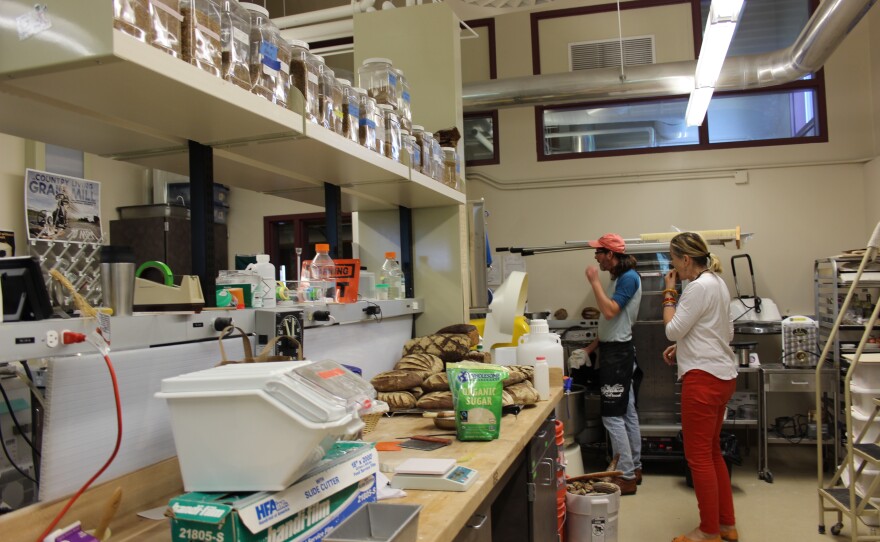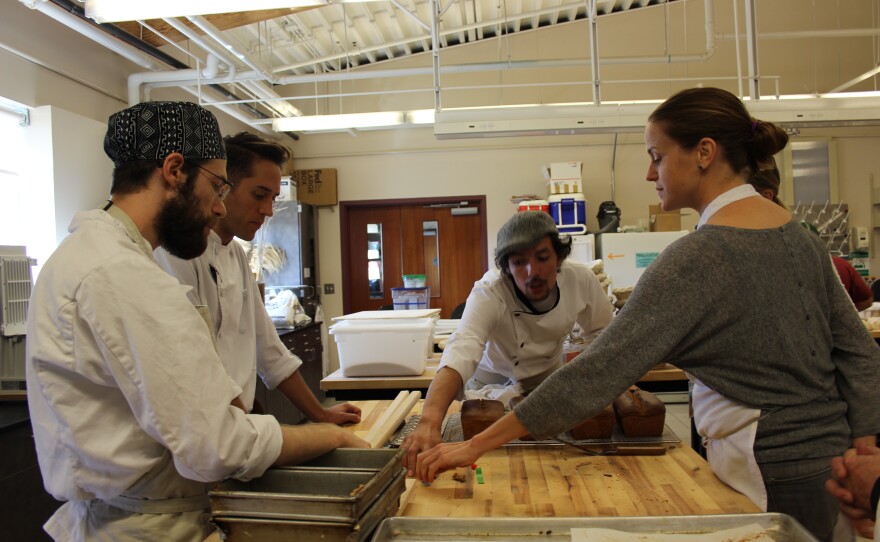People usually go to Skagit Valley for tulips and berries. But here’s a little known fact: The region also grows grains. Grains used to be grown mainly as cover crop and often shipped out of state. These days Skagit Valley is seeing a grain revival, thanks to a local researcher.
If your experience with whole grain bread takes you back to the hard brick loaves of the '70s, Stephen Jones at the Bread Lab wants to change that.
[asset-images[{"caption": "Jim Lahey (left) of Sullivan Bakery in New York, joins Bread Lab director Stephen Jones at the annual Grain Gathering in Skagit Valley. ", "fid": "73865", "style": "card_280", "uri": "public://201409/BreadLab-Steven_2.JPG", "attribution": "Credit KUOW Photo/Kara McDermott"}]]He shows me some freshly baked sourdough loaves cooling in the kitchen. “We’ll cut into some,” he says, “and you’ll see how moist they are.”
Jones says the loaves were made with a variety of French wheat grown here and were baked in a superhot oven which gives them a deep caramelized color.
Jones is a plant geneticist and director of the Bread Lab, an extension of Washington State University. Just like heirloom tomatoes have made a comeback to the table, Jones wants to bring back long forgotten grains. He takes traits of the old grains and incorporates them into modern ones. Jones says the blend produces better grains overall.
“It has high iron, high zinc,” he says, “and it’s flavorful and makes a good product, whatever the product is.”
In the Bread Lab, scientists work side by side with farmers and bakers. Jones says their grains have to work for everyone in the food chain. Researchers analyze the grains for their nutritional value and the characteristics of the dough. The lab’s resident baker, Jonathan Bethony-McDowell, then takes the information and finds the best uses for these grains.
“I will often take unlikely characters and try to make them superstars,” he says.
[asset-pullquotes[{"quote": "If you pick up a plastic wrap bread in the store, it has probably 20 to 25 ingredients, and those are 20 to 25 ingredients you don't need in your bread.", "style": "inset"}]]Traditionally, flour is made from the inside of the wheat kernel. The bran and the rest of the shell — the nutritious stuff — get thrown out. This morning McDowell and a visiting baker from Paris will use some of the bran to make madeleines and croissants.
Whole grains are on their way to superstar status, at least in the food world. Notable chefs and bakers around the country have come to the Bread Lab, staying as long as six months to learn about the different varieties and to develop new recipes with them. It’s part of the farm-to-table trend as people seek alternatives to wheat from the commodity stream.
Whole grains have gotten a bad rap. Stephen Jones says we lost our way when we started growing grains for higher yield and processing them for convenience. “If you pick up a plastic wrap bread in the store, even one that looks pretty darn groovy, it has probably 20 to 25 ingredients,” he says, “and those are 20 to 25 ingredients you don’t need in your bread.”
Jones says bread dough needs plenty of time to ferment, which allows the gluten protein to break down. Instead we’ve been adding stuff to speed up the process.
[asset-images[{"caption": "", "fid": "73866", "style": "placed_wide", "uri": "public://201409/BreadLab-widedip1_1.jpg", "attribution": "Credit KUOW Photo/Kara McDermott"}]]
Jones grew his first wheat crop in the '70s while in college. He continued his work in wheat breeding when he came to WSU in Eastern Washington. But the wheat varieties he worked with didn’t excite him. “It had no name and it had no place and I wasn’t real comfortable with that,” he explains. “I started working with on organic wheat and wheat that’s sort of out place, like Western Washington.”
In 2008 Jones moved to Skagit Valley and started the Bread Lab. “Being an ex-commodity wheat breeder is like being an ex-smoker,” he says, “you don’t like to be around it.”
Jones says opening the Bread Lab here allows it to be closer to the heart of wheat farming in Skagit Valley. And farmers are catching on.
[asset-images[{"caption": "Seven years ago, grain farmer Tom Hunton grew grass seeds and commodity wheat for export. These days he grows several varieties of grains that he sells directly to bakers and restaurants. ", "fid": "73868", "style": "placed_left", "uri": "public://201409/BreadLab-FarmerTom_0.JPG", "attribution": "Credit KUOW Photo/Kara McDermott"}]]Tom Hunton, from Willamette Valley, Oregon, is among them. About seven years ago, Hunton gave up raising grass seed and commodity wheat for export. He began to grow hard red and white spring wheat. Now he sells them directly to bakers and local restaurants.
“It’s neat to be able to take someone out to a restaurant and say, all of these tortillas were made with flour that we grew, we milled,” he says.
And the reward is beyond financial; he values closer ties to his customers. “People want that connection and the story. They want us to make money because they want us — we’re now a critical part of their food system and they want you to be successful.”
The Bread Lab holds a workshop each year that brings together chefs, bakers, farmers and even brewers from around the country and Canada. It’s a chance to share knowledge, experience and enthusiasm for artisan grains.
States like Vermont, Maine and North Carolina are also reviving their local grain economies. Jones says it’s not just that retro is cool again, it’s about creating food that evokes a region, like grapes for Champagne; it creates distinction.
“One of my students is working on just colors of the grain. They’re just incredibly beautiful black and purple wheats, which don’t work in the commodity market,” he says. “But his strategy is to use it as signature or marker so when people see these blue or purple wheats, they know it’s from Western Washington.”
And at the Bread Lab, different is good.
[asset-images[{"caption": "Bobby Schafer, visiting baker from Chicago.", "fid": "73869", "style": "placed_wide", "uri": "public://201409/BreadLab-dip3_0.jpg", "attribution": "Credit KUOW Photo/Kara McDermott"}]]
Jonathan Bethony-McDowell shows off ideal dough folding technique:
http://youtu.be/LJthjJoQINE





